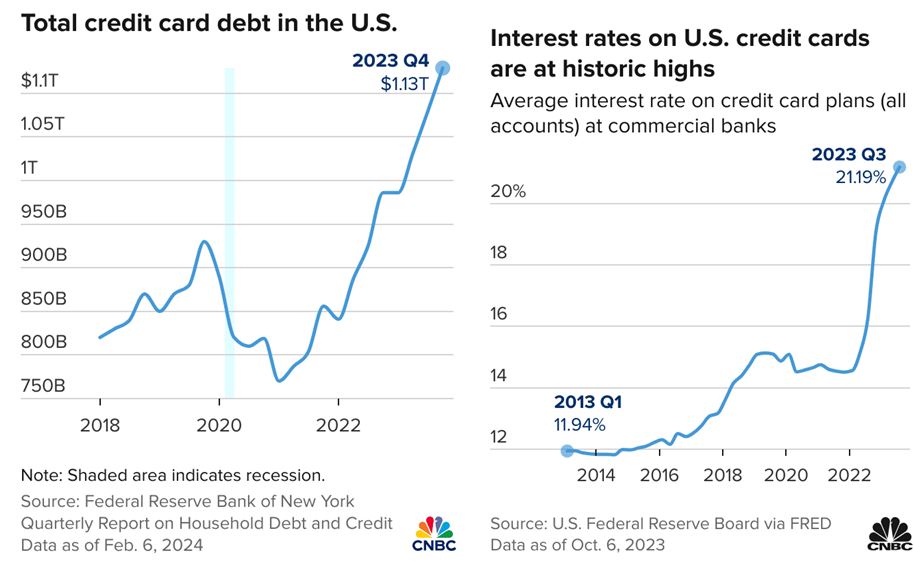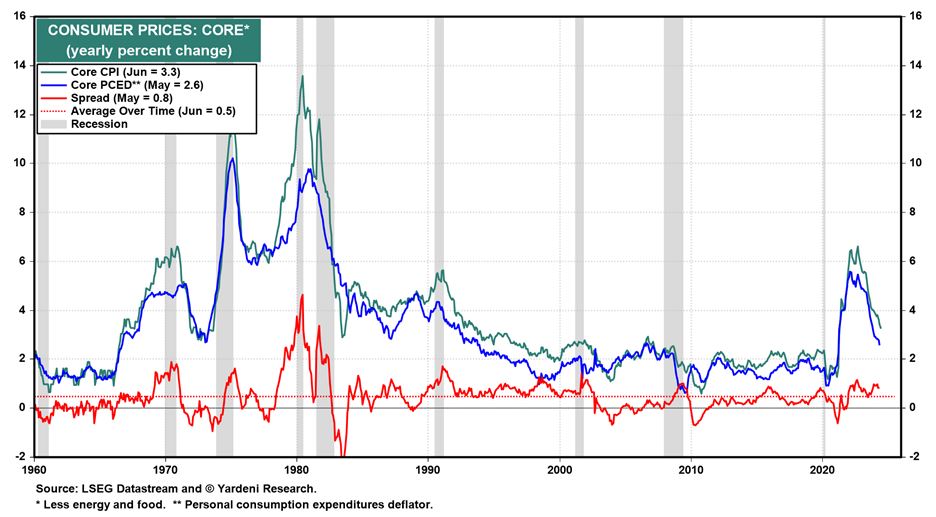by Gary Alexander
July 23, 2024
The White House just raised its array of numbers across the board – and showed no shame in doing so, despite the upcoming election. The Office of Management and Budget (OMB) just forecast that the Consumer Price Index (CPI) will rise 3.1% this year, up from its previous target of 2.5%, and they also forecast that the 2024 budget deficit will rise to $1.87 trillion (6.6% of GDP) and then inch up to $1.88 trillion in fiscal year 2025, starting October 1, just five weeks before the Election Day of Judgement.
Will inflation really rise back to 3.1% this year? It depends on where you live, I suppose. I just returned from the Freedom Fest in Las Vegas, where the cost of a bar drink in our conference there tripled, from $8 to $24 at the same host hotel from two years ago. The drink cost the same in our rooms: $24 for a 1.5-ounce nip of liquor, or $15 for a small bottle of water or soda – and don’t you dare lift it up to count the ounces or you automatically get charged by a little magnet underneath. Your room rate is reasonable, but you get charged $53 more per night for a “resort fee” and $100 a night for “incidentals” (like looking at a bottle). One speaker forgot to bring a jacket, so he shopped for one at the nearby malls and the cheapest jacket he found (of any quality) was $2,200. And don’t even ask about show prices or gambling odds.
So, I returned home last week to an $8,000 bill for clearing some trees (up from $5,000 five years ago), mostly due to higher labor costs, and a doubling of our property taxes over the last decade due to higher real estate prices in our desirable region. My auto insurance is up 60% in the last three years, even though I drive under 4,000 miles a year on a small island (at low speeds) and haven’t filed a claim in 40+ years.
I’m not complaining. I still work, save and invest a lot at 79, so I can afford it, but many retirees cannot. It’s what my children and grandchildren have to endure that ticks me off, so I propose action… soon.
Housing and Other Interest-Related Costs are Rising the Fastest
We share our retirement home with one of our children and two adult grandchildren (all from Portland) because they’re delightful people who help this aging couple around the house – and also because costs are rising in Oregon, and buying or renting is rising out of their reach. In Friday’s Wall Street Journal (“Get Ready to Pay More for Electricity”), we learn that Portland’s major electric company “this year raised residential rates by about 17%. The company is seeking regulatory approval for another 7.2% increase next year.” Electricity demand is soaring, but supply is flat due to Biden’s Green New Deal policies.
Our children (all in their 50s now) recently shared with us the online prices of the homes they remember so well from their youth. Our first two children were born in an apartment overlooking the Rose Bowl in Pasadena, for which we paid $75 a month in rent! When we were expecting our third child in 1972, we bought our first home on Las Lunas St. We “shot the moon” for $19,500, putting only $500 down, with FHA financing. We sold that home in 1979 for a four-fold gain at $79,000 and thought we were geniuses. But today, Redfin says that 1,727 square foot hacienda is worth $1.47 million, up 75-fold in 52 years.
These days, we have children and grandchildren living in San Francisco – where the average home costs $1.3 million – and Portland, where the average home costs $541,000, not counting rising taxes, fees, and insurance. The cost of buying a coastal home is prohibitive, even to my well-off Silicon Valley engineer grandson making six figures. Homes are generally more affordable in the center of the country, but the typical monthly mortgage cost has still virtually doubled in 2-3 years, from $1,746 in 2021 to $3,322 now.

Graphs are for illustrative and discussion purposes only. Please read important disclosures at the end of this commentary.
As I’ve mentioned here before, debt service is not included in the CPI, so mortgage costs are not part of the Fed’s target rate of 2%. You might argue that “owners’ equivalent rent” factors in some of that cost, but it does not cover rising car loan costs nor rising credit card debt, and those rates are soaring. Credit card debt levels have doubled in the last two years. The combination of higher rates (21.2% at end-2023 vs. 14.5% in 2021), and higher debt levels ($1.13 trillion at end-2023 vs. $775 billion 2021) yields $236 billion in annual credit card interest now vs. $112 billion in 2021 – more than doubling in just two years.

Graphs are for illustrative and discussion purposes only. Please read important disclosures at the end of this commentary.
Due to high and rising housing costs, The Wall Street Journal reported last Monday, July 15th (“Evictions Surge in Major Cities in the Sunbelt), that eviction filings in a half-dozen cities and their surrounding metropolitan areas are up 35% or more (vs. pre-2020 norms) in the last year, according to the Eviction Lab, a research unit at Princeton University. In Phoenix, landlords filed more than 8,000 eviction notices in January alone, the most ever in the Arizona capital in a single month. Nationwide, the asking rents for houses and apartments are up 30% between 2020 and 2023, according to the Zillow Observed Rent Index.
With most other household costs – food, energy, insurance and more – up about the same, many working families cannot afford rent and are being evicted, so I have a humble proposal for the Federal Reserve.
To fight inflation, Chairman Powell, CUT INTEREST RATES NOW – on July 31st, and September 18th.
The next PCED – the Fed’s favorite inflation index – will be released this Friday, July 26. Then, the Fed’s Open Market Committee (FOMC) will meet next Tuesday and Wednesday (July 30-31), to set interest rate policy. If Friday’s PCED is mild enough, the Fed will have reason enough to make a small (0.25%) rate cut on July 31, to signal their intention, and then perhaps reduce rates more (by 0.50%) in September.

Graphs are for illustrative and discussion purposes only. Please read important disclosures at the end of this commentary.
The blue line (PCED) is near the Fed’s 2% target, so with any luck it will hit 2% Friday and the Fed will act next week. Any rate cut will also reduce our service costs on the massive $34 trillion federal deficit.
It’s a win-win move, so “Bring down that interest rate wall against debtors and homeowners, Mr. Powell.”
All content above represents the opinion of Gary Alexander of Navellier & Associates, Inc.
Also In This Issue
A Look Ahead by Louis Navellier
The Best Tech and Energy Stocks Should Remain Strong
Income Mail by Bryan Perry
Riding Out Summer Volatility with the “Mag 7” Earnings on Deck
Growth Mail by Gary Alexander
“Mr. Powell, Tear Down This Interest Rate Wall!”
Global Mail by Ivan Martchev
It is Starting to Look like an Intermediate-Term Sell-Off
Sector Spotlight by Jason Bodner
Here’s Your “X-Ray Vision” Key to the Market
View Full Archive
Read Past Issues Here
About The Author

Gary Alexander
SENIOR EDITOR
Gary Alexander has been Senior Writer at Navellier since 2009. He edits Navellier’s weekly Marketmail and writes a weekly Growth Mail column, in which he uses market history to support the case for growth stocks. For the previous 20 years before joining Navellier, he was Senior Executive Editor at InvestorPlace Media (formerly Phillips Publishing), where he worked with several leading investment analysts, including Louis Navellier (since 1997), helping launch Louis Navellier’s Blue Chip Growth and Global Growth newsletters.
Prior to that, Gary edited Wealth Magazine and Gold Newsletter and wrote various investment research reports for Jefferson Financial in New Orleans in the 1980s. He began his financial newsletter career with KCI Communications in 1980, where he served as consulting editor for Personal Finance newsletter while serving as general manager of KCI’s Alexandria House book division. Before that, he covered the economics beat for news magazines. All content of “Growth Mail” represents the opinion of Gary Alexander
Important Disclosures:
Although information in these reports has been obtained from and is based upon sources that Navellier believes to be reliable, Navellier does not guarantee its accuracy and it may be incomplete or condensed. All opinions and estimates constitute Navellier’s judgment as of the date the report was created and are subject to change without notice. These reports are for informational purposes only and are not a solicitation for the purchase or sale of a security. Any decision to purchase securities mentioned in these reports must take into account existing public information on such securities or any registered prospectus.To the extent permitted by law, neither Navellier & Associates, Inc., nor any of its affiliates, agents, or service providers assumes any liability or responsibility nor owes any duty of care for any consequences of any person acting or refraining to act in reliance on the information contained in this communication or for any decision based on it.
Past performance is no indication of future results. Investment in securities involves significant risk and has the potential for partial or complete loss of funds invested. It should not be assumed that any securities recommendations made by Navellier. in the future will be profitable or equal the performance of securities made in this report. Dividend payments are not guaranteed. The amount of a dividend payment, if any, can vary over time and issuers may reduce dividends paid on securities in the event of a recession or adverse event affecting a specific industry or issuer.
None of the stock information, data, and company information presented herein constitutes a recommendation by Navellier or a solicitation to buy or sell any securities. Any specific securities identified and described do not represent all of the securities purchased, sold, or recommended for advisory clients. The holdings identified do not represent all of the securities purchased, sold, or recommended for advisory clients and the reader should not assume that investments in the securities identified and discussed were or will be profitable.
Information presented is general information that does not take into account your individual circumstances, financial situation, or needs, nor does it present a personalized recommendation to you. Individual stocks presented may not be suitable for every investor. Investment in securities involves significant risk and has the potential for partial or complete loss of funds invested. Investment in fixed income securities has the potential for the investment return and principal value of an investment to fluctuate so that an investor’s holdings, when redeemed, may be worth less than their original cost.
One cannot invest directly in an index. Index is unmanaged and index performance does not reflect deduction of fees, expenses, or taxes. Presentation of Index data does not reflect a belief by Navellier that any stock index constitutes an investment alternative to any Navellier equity strategy or is necessarily comparable to such strategies. Among the most important differences between the Indices and Navellier strategies are that the Navellier equity strategies may (1) incur material management fees, (2) concentrate its investments in relatively few stocks, industries, or sectors, (3) have significantly greater trading activity and related costs, and (4) be significantly more or less volatile than the Indices.
ETF Risk: We may invest in exchange traded funds (“ETFs”) and some of our investment strategies are generally fully invested in ETFs. Like traditional mutual funds, ETFs charge asset-based fees, but they generally do not charge initial sales charges or redemption fees and investors typically pay only customary brokerage fees to buy and sell ETF shares. The fees and costs charged by ETFs held in client accounts will not be deducted from the compensation the client pays Navellier. ETF prices can fluctuate up or down, and a client account could lose money investing in an ETF if the prices of the securities owned by the ETF go down. ETFs are subject to additional risks:
- ETF shares may trade above or below their net asset value;
- An active trading market for an ETF’s shares may not develop or be maintained;
- The value of an ETF may be more volatile than the underlying portfolio of securities the ETF is designed to track;
- The cost of owning shares of the ETF may exceed those a client would incur by directly investing in the underlying securities; and
- Trading of an ETF’s shares may be halted if the listing exchange’s officials deem it appropriate, the shares are delisted from the exchange, or the activation of market-wide “circuit breakers” (which are tied to large decreases in stock prices) halts stock trading generally.
Grader Disclosures: Investment in equity strategies involves substantial risk and has the potential for partial or complete loss of funds invested. The sample portfolio and any accompanying charts are for informational purposes only and are not to be construed as a solicitation to buy or sell any financial instrument and should not be relied upon as the sole factor in an investment making decision. As a matter of normal and important disclosures to you, as a potential investor, please consider the following: The performance presented is not based on any actual securities trading, portfolio, or accounts, and the reported performance of the A, B, C, D, and F portfolios (collectively the “model portfolios”) should be considered mere “paper” or pro forma performance results based on Navellier’s research.
Investors evaluating any of Navellier & Associates, Inc.’s, (or its affiliates’) Investment Products must not use any information presented here, including the performance figures of the model portfolios, in their evaluation of any Navellier Investment Products. Navellier Investment Products include the firm’s mutual funds and managed accounts. The model portfolios, charts, and other information presented do not represent actual funded trades and are not actual funded portfolios. There are material differences between Navellier Investment Products’ portfolios and the model portfolios, research, and performance figures presented here. The model portfolios and the research results (1) may contain stocks or ETFs that are illiquid and difficult to trade; (2) may contain stock or ETF holdings materially different from actual funded Navellier Investment Product portfolios; (3) include the reinvestment of all dividends and other earnings, estimated trading costs, commissions, or management fees; and, (4) may not reflect prices obtained in an actual funded Navellier Investment Product portfolio. For these and other reasons, the reported performances of model portfolios do not reflect the performance results of Navellier’s actually funded and traded Investment Products. In most cases, Navellier’s Investment Products have materially lower performance results than the performances of the model portfolios presented.
This report contains statements that are, or may be considered to be, forward-looking statements. All statements that are not historical facts, including statements about our beliefs or expectations, are “forward-looking statements” within the meaning of The U.S. Private Securities Litigation Reform Act of 1995. These statements may be identified by such forward-looking terminology as “expect,” “estimate,” “plan,” “intend,” “believe,” “anticipate,” “may,” “will,” “should,” “could,” “continue,” “project,” or similar statements or variations of such terms. Our forward-looking statements are based on a series of expectations, assumptions, and projections, are not guarantees of future results or performance, and involve substantial risks and uncertainty as described in Form ADV Part 2A of our filing with the Securities and Exchange Commission (SEC), which is available at www.adviserinfo.sec.gov or by requesting a copy by emailing info@navellier.com. All of our forward-looking statements are as of the date of this report only. We can give no assurance that such expectations or forward-looking statements will prove to be correct. Actual results may differ materially. You are urged to carefully consider all such factors.
FEDERAL TAX ADVICE DISCLAIMER: As required by U.S. Treasury Regulations, you are informed that, to the extent this presentation includes any federal tax advice, the presentation is not written by Navellier to be used, and cannot be used, for the purpose of avoiding federal tax penalties. Navellier does not advise on any income tax requirements or issues. Use of any information presented by Navellier is for general information only and does not represent tax advice either express or implied. You are encouraged to seek professional tax advice for income tax questions and assistance.
IMPORTANT NEWSLETTER DISCLOSURE:The hypothetical performance results for investment newsletters that are authored or edited by Louis Navellier, including Louis Navellier’s Growth Investor, Louis Navellier’s Breakthrough Stocks, Louis Navellier’s Accelerated Profits, and Louis Navellier’s Platinum Club, are not based on any actual securities trading, portfolio, or accounts, and the newsletters’ reported hypothetical performances should be considered mere “paper” or proforma hypothetical performance results and are not actual performance of real world trades. Navellier & Associates, Inc. does not have any relation to or affiliation with the owner of these newsletters. There are material differences between Navellier Investment Products’ portfolios and the InvestorPlace Media, LLC newsletter portfolios authored by Louis Navellier. The InvestorPlace Media, LLC newsletters contain hypothetical performance that do not include transaction costs, advisory fees, or other fees a client might incur if actual investments and trades were being made by an investor. As a result, newsletter performance should not be used to evaluate Navellier Investment services which are separate and different from the newsletters. The owner of the newsletters is InvestorPlace Media, LLC and any questions concerning the newsletters, including any newsletter advertising or hypothetical Newsletter performance claims, (which are calculated solely by Investor Place Media and not Navellier) should be referred to InvestorPlace Media, LLC at (800) 718-8289.
Please note that Navellier & Associates and the Navellier Private Client Group are managed completely independent of the newsletters owned and published by InvestorPlace Media, LLC and written and edited by Louis Navellier, and investment performance of the newsletters should in no way be considered indicative of potential future investment performance for any Navellier & Associates separately managed account portfolio. Potential investors should consult with their financial advisor before investing in any Navellier Investment Product.
Navellier claims compliance with Global Investment Performance Standards (GIPS). To receive a complete list and descriptions of Navellier’s composites and/or a presentation that adheres to the GIPS standards, please contact Navellier or click here. It should not be assumed that any securities recommendations made by Navellier & Associates, Inc. in the future will be profitable or equal the performance of securities made in this report.
FactSet Disclosure: Navellier does not independently calculate the statistical information included in the attached report. The calculation and the information are provided by FactSet, a company not related to Navellier. Although information contained in the report has been obtained from FactSet and is based on sources Navellier believes to be reliable, Navellier does not guarantee its accuracy, and it may be incomplete or condensed. The report and the related FactSet sourced information are provided on an “as is” basis. The user assumes the entire risk of any use made of this information. Investors should consider the report as only a single factor in making their investment decision. The report is for informational purposes only and is not intended as an offer or solicitation for the purchase or sale of a security. FactSet sourced information is the exclusive property of FactSet. Without prior written permission of FactSet, this information may not be reproduced, disseminated or used to create any financial products. All indices are unmanaged and performance of the indices include reinvestment of dividends and interest income, unless otherwise noted, are not illustrative of any particular investment and an investment cannot be made in any index. Past performance is no guarantee of future results.
